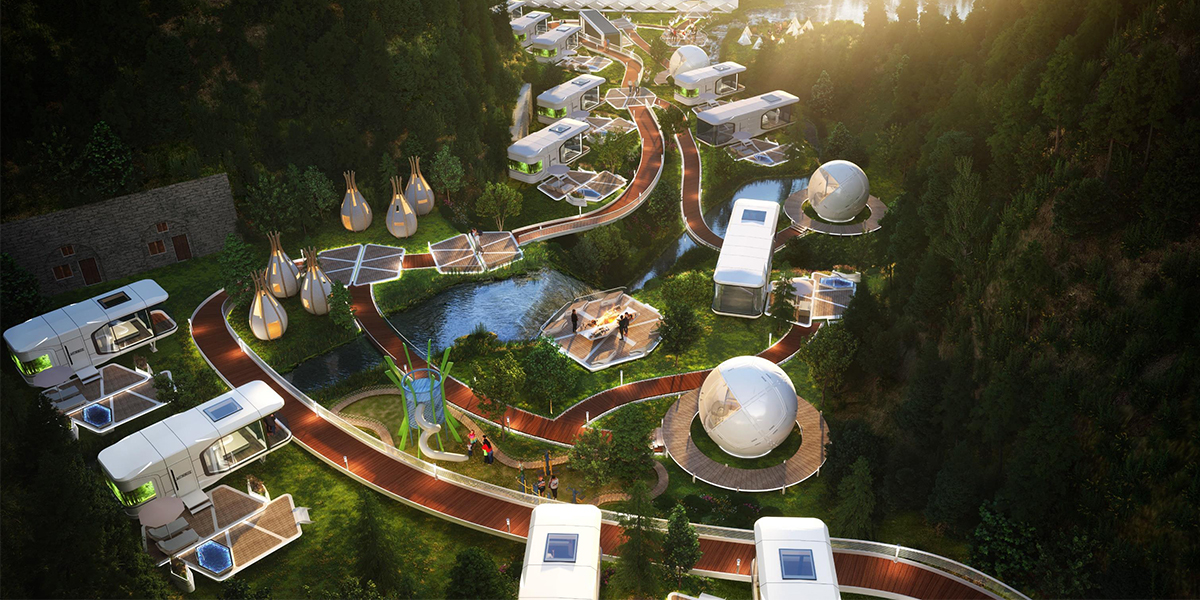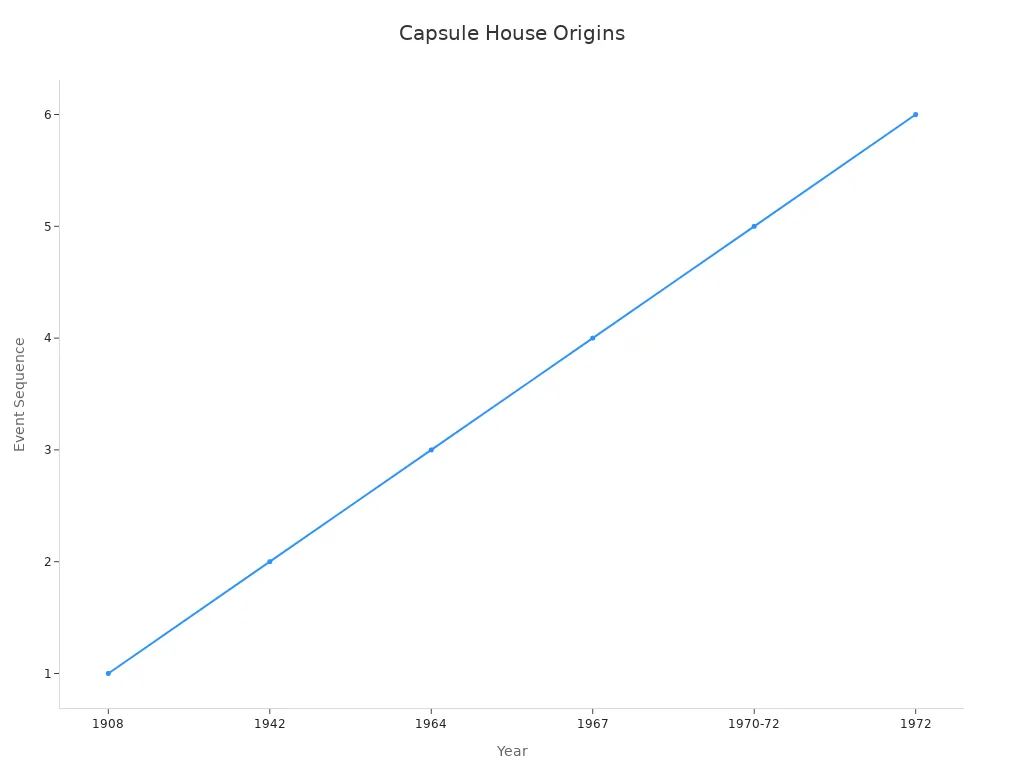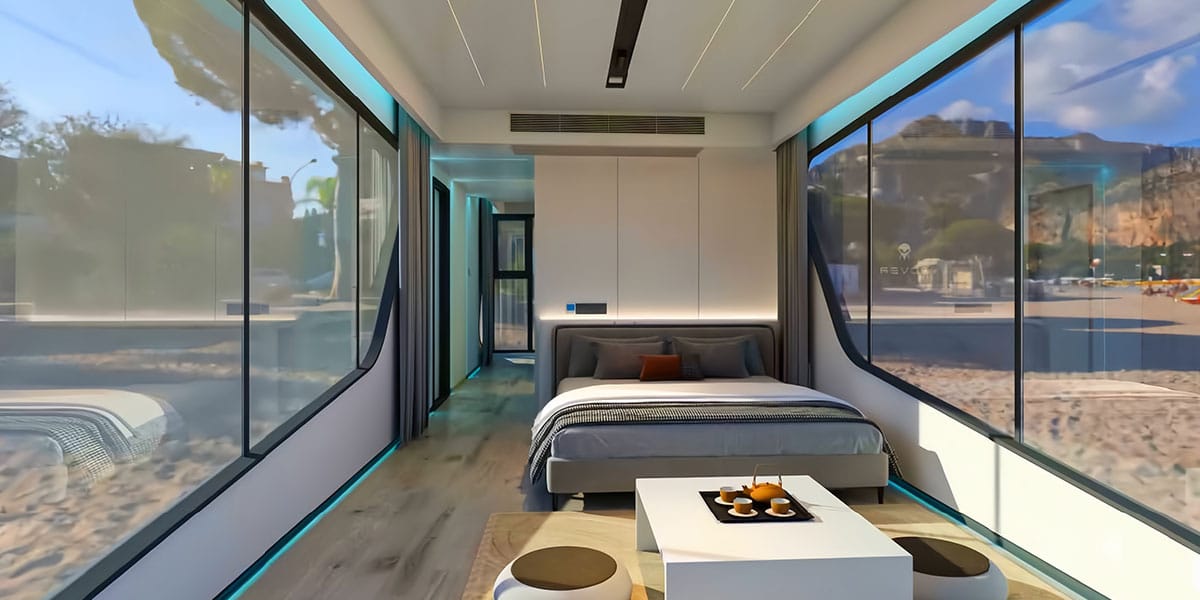
09 Jul Tracing the Origins and Growth of Capsule House Architecture
Table of Contents
Capsule house architecture started as a brave answer to city problems. Modernism helped form the first ideas. After the war, architects had to think in new ways. The nakagin capsule tower in Tokyo is a sign of this style. Architects used capsule units to make spaces that could change. Each capsule gave people a special way to live. The nakagin capsule tower showed how capsule house design works in crowded cities. Today, capsule house architecture draws people who want smart and useful homes. The capsule idea still inspires new buildings everywhere.
Key Takeaways
Capsule house architecture started after World War II. It was made to fix city housing problems. The designs are fast, flexible, and modern. The Nakagin Capsule Tower is in Tokyo. It is a famous example of this style. Modular capsules make small, changeable living spaces. Capsule homes use smart technology and green materials. This helps save energy and reduce waste. It also makes small spaces feel comfortable. These homes work well in crowded cities. They help with housing shortages. They give people cheap and easy-to-change places to live. Capsule houses show a bright future for cities. They mix smart design, green ideas, and modular building.
Origins of Capsule House
Modernism and Post-War Influence
Modernism made people see architecture in a new way. After World War II, cities needed homes quickly. Architects wanted to build houses fast and move them easily. They used new materials and simple shapes. This led to the first capsule house designs. In 1908, Sears sold homes you could put together yourself. People liked building houses in parts. By 1942, Skidmore, Owings & Merrill built Oak Ridge modular town in Tennessee. This town used plug-and-play housing units. These projects helped start the idea of capsule houses.
In the 1960s, architects everywhere tried modular living. Guy Dessauges made capsule houses on pylons. Moshe Safdie built Habitat 67 in Montreal. This building used 354 concrete modules for bright, open homes. Paul Rudolph worked on Oriental Masonic Gardens. He stacked prefabricated units around a center. These projects showed how capsule house architecture could help crowded cities.
Capsule house designs came from the need for fast, flexible, and modern homes after the war.
Here is a table showing important people and dates in early capsule house architecture:
Year | Architect/Group | Project/Contribution | Notes |
|---|---|---|---|
1908 | Sears | Prefabricated homes | Early modular housing concept |
1942 | Skidmore, Owings & Merrill | Oak Ridge modular town, Tennessee | Plug-and-play housing units |
Early 1960s | Guy Dessauges | Capsule houses on pylons | Modular capsule houses with panoramic views |
1964 | Archigram (UK) | Plug-In City (concept) | Futuristic modular city concept |
1967 | Moshe Safdie | Habitat 67, Montreal Expo | 354 prefabricated modules, focus on light and open space |
1970-72 | Paul Rudolph | Oriental Masonic Gardens | 148 prefabricated units, stacked living spaces |

Metabolist Movement
The Metabolist movement began in Japan in the 1960s. These architects wanted buildings to grow and change like living things. They called this idea metabolism. Kisho Kurokawa and others thought cities should change over time. They used capsules as the main parts of buildings. Each capsule could be added or taken away. This made the buildings flexible and ready for the future.
Metabolism in architecture means buildings can change as people need. The Metabolists used new technology to make capsule units. These units could be moved or replaced easily. Kisho Kurokawa saw each capsule as a living cell. He wanted buildings to have a life cycle like nature. The Metabolist movement helped architects use modular design and new ways to build. This changed how people saw capsule house design.
Arata Isozaki, another Metabolist, designed Clusters in the Air. This project used capsules as leaves, branches, and trunks. The idea showed a city could grow like a tree. The Metabolist movement made a big impact on capsule house architecture. It showed how metabolism could shape the future of cities.
Nakagin Capsule Tower
The Nakagin Capsule Tower is the most famous capsule house building. Kisho Kurokawa designed it in Tokyo. Construction finished in 1972 after two years. The tower has two concrete cores. One has 11 floors and the other has 13. Workers attached 140 capsules to these towers. Each capsule is 2.5 meters by 2.5 meters by 4.0 meters. The round window is 1.3 meters wide. Each capsule connects to the core with four strong bolts. This lets workers remove or replace capsules easily.
The Nakagin Capsule Tower shows the power of metabolism in buildings. Each capsule is a small home with furniture and a bathroom. People could use the capsules as offices or apartments. The total floor area is 3,091.23 square meters. In 2012, about 30 capsules were still used. The tower became a symbol of postwar Japan and modern capsule house design. Many people see it as an important building.
Here is a table with key facts about the Nakagin Capsule Tower:
Feature | Detail |
|---|---|
Completion Year | 1972 (after 2 years of construction) |
Number of Towers | 2 (interconnected concrete towers) |
Tower Heights | 11 and 13 floors |
Total Capsules | 140 self-contained prefabricated units |
Capsule Dimensions | 2.5 m × 2.5 m × 4.0 m |
Capsule Window Diameter | 1.3 m circular window |
Capsule Attachment Method | Independent, via 4 high-tension bolts |
Total Floor Area | 3,091.23 m² (33,273.7 sq ft) |
Capsules in Use (2012) | About 30 remaining |
Architectural Style | Japanese Metabolism |
Significance | World’s first permanent capsule architecture, emblematic of postwar Japan |
The Nakagin Capsule Tower changed how people think about living in capsule houses. It proved metabolism and modular design could work in real life. The tower inspired architects everywhere to try new ways to use capsules in buildings.
Evolution of Capsule Homes
 Experimental Designs
Experimental Designs
Architects try new ideas with capsule homes. They use creative designs to make small spaces work well. Many capsule houses have space-saving furniture like foldable beds. Some have hidden storage to keep things tidy. These features help people use every part of the home. Designers pick materials like recycled steel and bamboo. These choices are better for the environment. Some capsule homes have wheels or light frames. This makes them easy to move or use as guest houses. Builders use modular construction to put homes together fast. They can change the design for different needs. Smart home technology is common in capsule homes now. People use voice controls for lights and smart thermostats. These new ideas make capsule homes more useful and flexible.
Global Spread
Capsule homes are now popular in many countries. Cities in Europe, the United States, and Australia use them. They help with housing shortages in busy places. Governments support modular housing with special programs. This helps more people get homes. Capsule homes show a global move to smaller, cheaper, and flexible living. Many cities build capsule homes for young workers and students. These people want small homes and micro-living options. The COVID-19 pandemic made more people want safe capsule homes. Some have touchless technology for health. The market for capsule homes keeps growing every year. Experts think it will grow by 8.9% each year until 2032.
Adaptation in Urban Living
People in cities like capsule homes because space is limited. Capsule house architecture helps people live in small areas. Modular layouts let people change their homes for different uses. Many capsule homes use solar panels and LED lights. These systems save money and help the planet. Capsule homes are now used for short-term rentals and off-grid living. Young people and professionals like capsule homes for their simple style. They also like how easy they are to change. Urban housing is changing with metabolism, modular design, and flexible capsule living.
Key Features of Capsule Homes
Modularity and Flexibility
Capsule homes are special because they use modular design. Architects build them with parts that can change as needed. Each capsule connects to a main core. People can add or take away capsules to make their homes bigger or smaller. This helps families grow or make new work areas without moving. NeoCapsules use a special core that lets people change spaces easily. Standard sizes and connection spots make it simple to swap or add new parts.
Modularity in capsule house architecture makes building fast and easy. It also helps save time and money.
Capsule homes often have shades you can control and spaces for cranes. These features help with future changes and upgrades. Studies show modular homes can change shape in many ways. People can make their homes look different by moving parts around. Modular homes are lighter because they use fewer moving parts. Robots can help build them, which makes them safer and better.
Modular capsule homes let people:
- Change homes for new needs
- Make homes bigger or smaller
- Use standard parts for easy fixes
- Move in or out quickly
Capsule house architecture uses modularity to make city living easy, green, and smart.
Technology Integration
Technology is very important in capsule homes today. Architects add smart systems so people can control their homes. Lights and heat can turn on or off by themselves to save energy. Many capsule homes have furniture that does more than one thing, like beds that fold into sofas. These ideas make small spaces feel bigger and nicer.
Capsule homes use strong materials like galvanized steel and special aluminum. These materials help the homes last over 50 years. Good insulation and energy-saving windows keep homes comfy in hot or cold weather. Some capsule homes can stand up to strong storms and big earthquakes.
Important technology in capsule homes:
- Smart controls for lights, heat, and safety
- Automatic features for comfort
- Energy-saving appliances and systems
- Digital check-ins at capsule hotels
- Furniture that saves space and has many uses
More people want capsule homes every year. Experts think the market will be worth $228.9 billion by 2030. This is because people want homes that are cheap, smart, and good for the planet. Capsule house architecture uses technology to make homes safer, easier, and more comfortable.
Sustainable Capsule Houses
Sustainable capsule houses are made to be good for the earth. Architects pick green materials like recycled steel, bamboo, and wood. Capsule homes use less power with LED lights and heaters that save energy. Their small size and smart building help lower pollution compared to regular homes.
Building capsule homes in factories makes less trash. For example, using plaster in capsule homes can cut waste by 100%. Using timber and concrete also makes less waste than normal building. Capsule homes use space well, so they save land in cities and the countryside.
Green features in sustainable capsule houses:
- Use of recycled and green materials
- Less material used for less harm to nature
- Solar panels, wind turbines, and geothermal energy
- Strong insulation for saving energy
- Smart systems to watch and control energy use
- Sharing energy with neighbors for better results
Capsule homes often have solar panels to make electricity from sunlight. Wind turbines and geothermal systems give clean power and heat or cool the home. The small size means less energy is needed for lights and heat. Smart systems help people see how much energy they use and save more. People can check how much energy they make and use with special monitors.
Sustainable capsule houses show how buildings can help people live green. They help save money on energy and use less oil and gas.
Capsule homes do have some problems, like recycling and fixing things. Using strong materials and smart building helps with these issues. Sustainable capsule houses are leading the way in green, modular homes and set new rules for saving energy and helping the planet.
Applications of Space Capsule House
 Capsule Hotels
Capsule Hotels
Capsule hotels use capsule homes to give travelers a private place to sleep. These hotels started in Japan and are now in many cities. Each capsule gives guests a small space with a bed and light. Some capsules have a TV too. Capsule hotels cost less than normal hotels and save space. Most guests are solo travelers or young adults. They like the privacy and low price.
A table below shows important facts about capsule hotels:
Metric | Data/Statistic |
|---|---|
USD 263.8 million | |
Solo Travelers Market Share | 70.6% |
Young Adults (18-24) Share | 41.2% |
Profit Margin | Up to 40% |
Asia Pacific Market Share | 60.1% |
Capsule hotels fill up fast. About 30% of bookings are by the hour. Half of the guests stay less than a day. These hotels help people who need a cheap, short stay. Investors like capsule hotels because they make good money and cost less to run.
Urban Housing
Cities use space capsule house designs to fix housing problems. Capsule homes fit in small spaces and help more people live in crowded places. Builders can put up capsule homes fast with modular construction. People can add or take away capsules to change their home size. This makes capsule homes good for families and workers.
Capsule homes help people find cheaper places to live in cities. Prices for a space capsule house go from $20,000 to over $100,000. This makes them a good and green choice instead of regular apartments. Many young workers and students pick capsule homes because they are cheap and easy to care for. Cities also use capsule homes for emergencies after disasters.
Capsule homes help cities grow without using too much land. They are a smart way to give more people homes.
Off-Grid Solutions
People use space capsule house models to live off-grid. Capsule homes work well in far places because they are easy to move and set up. Builders use green materials and smart systems to save energy. Solar panels, wind turbines, and good insulation help capsule homes work without city power.
Adventure tourism companies use capsule homes as fun cabins. Emergency teams use capsule homes as quick shelters after storms or fires. Some capsule homes use satellite and other tech to stay connected far away. These features make capsule homes great for people who want to live simply and help the planet.
A list of reasons why capsule homes work well off-grid:
- Easy to build and move
- Use clean energy and save power
- Stay safe and connected with smart tech
- Help people live green
Capsule homes show how space capsule house ideas help people live anywhere. They give more choices for homes and help make the future greener.
Challenges & Sustainable Living Future
 Social Acceptance
Social Acceptance
People think capsule homes are a new way to live. Many like that they help the planet and use less energy. Some people worry about not having enough privacy or space. Capsule homes often have open rooms, so it is hard to be alone. Big families may find these homes too small for everyone. Younger people, like Millennials and Gen Z, are more interested in capsule homes. They like that these homes cost less, look simple, and have cool designs. More people accept capsule homes as they learn about metabolism in architecture. As cities get bigger, capsule homes keep changing how people live.
Regulations
Capsule homes must follow many rules in different places. Some cities have laws that make it hard to build small or green homes. These rules can slow down new ways to build in cities. Some countries, like Germany and the UK, now help with capsule home projects. Programs like the Modular Housing Incentive Program help cities such as Munich and Manchester. These programs support new ideas in housing and metabolism. Capsule homes are quick to build and strong, so they meet safety rules. The table below shows some problems and good things about capsule homes:
Aspect | Summary |
|---|---|
Sustainability | |
Affordability | They cost less and are fast to build, so more people can get homes. |
Challenges | Rules and small spaces can make building harder. |
Structural Benefits | Capsule homes are strong against wind and earthquakes, so they are safe and green. |
Future of Sustainable Living
The future of green living depends on new ways to build homes. Capsule homes are leading this change with metabolism ideas. More people in cities means we need homes that save space and energy. By 2050, most people will live in cities. Capsule homes use solar panels, wind power, and good insulation. These things help save energy and protect the earth. Many capsule homes have solar panels and wind turbines. Their small size means less trash and less pollution. Metabolism and green design will change how people live in the future. Capsule homes give everyone a way to live in a green and smart home.
Key features for the future:
- Use of green materials
- Renewable energy like solar and wind
- Small, flexible design
- Fast to build and not expensive
- Help cities grow in a smart way
Capsule homes show how metabolism and change can make a better future for green living.
Capsule house architecture is changing how cities look today. The nakagin capsule tower is a famous example of new ideas. It shows that capsule design can help with space and being green. Capsule homes are built with parts that fit together. They use smart technology and materials that are good for the earth. The nakagin capsule tower gives ideas for new projects. These new capsule homes save energy and let people live in different ways. Capsule homes are cheap and help save space in crowded cities. The nakagin capsule tower shows that capsule design can change as people need. As cities get bigger, capsule homes will become more important. The nakagin capsule tower shows that capsule living can help cities stay green. Capsule homes will help people make a better future.
FAQ
What is a capsule house?
A capsule house is a small home you can live in. It is self-contained and has everything you need. Builders use modular construction to make these homes. Each capsule can be by itself or joined with others. Capsule houses often have smart technology and green materials.
Who invented the capsule house concept?
Kisho Kurokawa was a Japanese architect who started this idea. He made the Nakagin Capsule Tower in Tokyo. His work made other architects want to try modular and flexible homes.
Are capsule homes safe during earthquakes or storms?
Capsule homes use strong steel and reinforced concrete. Engineers make them to stand up to earthquakes and strong winds. Many capsule homes follow strict safety rules in places with bad weather.
Tip: Always look at local building codes for more safety.
How much does a capsule house cost?
Capsule home prices are different. Most cost between $20,000 and $100,000. The price changes with size, materials, and technology. Capsule homes usually cost less than regular houses.




 Experimental Designs
Experimental Designs Capsule Hotels
Capsule Hotels Social Acceptance
Social Acceptance